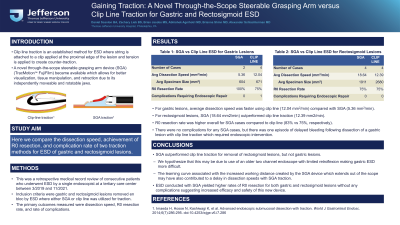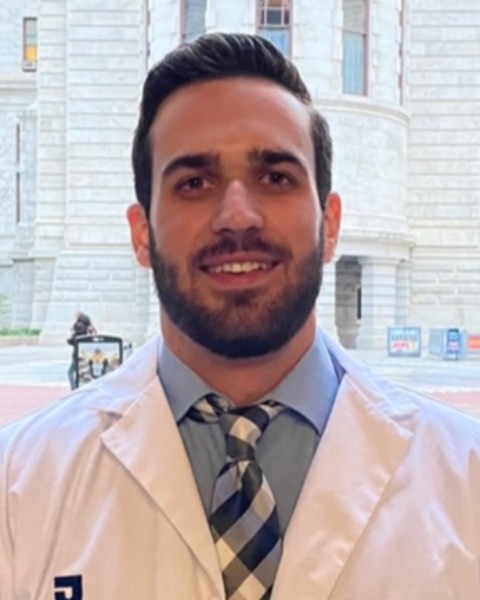Back


Poster Session D - Tuesday Morning
Category: Interventional Endoscopy
D0447 - Gaining Traction: A Novel Through-the-Scope Steerable Grasping Arm vs Clip Line Traction for Gastric and Rectosigmoid ESD
Tuesday, October 25, 2022
10:00 AM – 12:00 PM ET
Location: Crown Ballroom

Has Audio

Daniel Scanlon, BA
Thomas Jefferson University Hospital
Philadelphia, PA
Presenting Author(s)
Daniel Scanlon, BA1, Zachary Lieb, BS1, Brian Jacobs, BA2, Abhishek Agnihotri, MD1, Brianna Shinn, MD1, Alexander Schlachterman, MD1
1Thomas Jefferson University Hospital, Philadelphia, PA; 2Thomas Jefferson University Hospital, New Brunswick, NJ
Introduction: An important technical aspect of endoscopic submucosal dissection (ESD) is traction which leads to more successful dissections and reduced procedure times. Clip line (CL) traction is an established method where string is attached to a clip applied at the proximal edge of the lesion and tension is applied to create counter-traction. Recently, a novel through-the-scope steerable grasping arm device (SGA) (TracMotion™ FujiFilm) became available which allows for better visualization, tissue manipulation, and retraction due to its independently moveable and rotatable jaws. In this study, we compared the dissection speed, achievement of R0 resection and complication rate between these two traction methods for ESD of gastric and rectosigmoid lesions.
Methods: This was a retrospective medical record review of consecutive patients undergoing ESD by a single endoscopist at a tertiary care center between 3/2019 and 11/2021. Inclusion criteria included gastric and rectosigmoid lesions removed en bloc by ESD where either SGA or CL was utilized for traction. Data collected included ESD dissection time, instrumentation, lesion characteristics, resected specimen size, pathology interpretation, and complications.
Results: Four gastric and 4 rectosigmoid lesions were resected using CL traction, and 2 gastric and 4 rectosigmoid lesions were resected using SGA. For gastric lesions, the average dissection speed using CL was 12.04 mm2/min compared with an average dissection speed of 5.36 mm2/min using SGA. However, for rectosigmoid lesions, SGA (18.64 mm2/min) outperformed CL traction (12.39 mm2/min). R0 resection rate was higher overall for SGA cases compared to CL (83% vs 75%, respectively). There were no complications for any SGA cases. There was one episode of delayed bleeding following dissection of a gastric lesion with CL traction requiring endoscopic intervention.
Discussion: ESD dissection speed utilizing SGA outperformed CL for removal of rectosigmoid lesions. While this was not the case for gastric lesions, we hypothesize this may be due to the use of an older two channel endoscope with limited retroflexion making gastric ESD more difficult. Further, the learning curve associated with the increased working distance created by the SGA device may have contributed to the difference in dissection speeds. ESD conducted with SGA yielded higher rates of R0 resection for gastric and rectosigmoid lesions without any complications suggesting increased efficacy and safety of this new device.
Disclosures:
Daniel Scanlon, BA1, Zachary Lieb, BS1, Brian Jacobs, BA2, Abhishek Agnihotri, MD1, Brianna Shinn, MD1, Alexander Schlachterman, MD1. D0447 - Gaining Traction: A Novel Through-the-Scope Steerable Grasping Arm vs Clip Line Traction for Gastric and Rectosigmoid ESD, ACG 2022 Annual Scientific Meeting Abstracts. Charlotte, NC: American College of Gastroenterology.
1Thomas Jefferson University Hospital, Philadelphia, PA; 2Thomas Jefferson University Hospital, New Brunswick, NJ
Introduction: An important technical aspect of endoscopic submucosal dissection (ESD) is traction which leads to more successful dissections and reduced procedure times. Clip line (CL) traction is an established method where string is attached to a clip applied at the proximal edge of the lesion and tension is applied to create counter-traction. Recently, a novel through-the-scope steerable grasping arm device (SGA) (TracMotion™ FujiFilm) became available which allows for better visualization, tissue manipulation, and retraction due to its independently moveable and rotatable jaws. In this study, we compared the dissection speed, achievement of R0 resection and complication rate between these two traction methods for ESD of gastric and rectosigmoid lesions.
Methods: This was a retrospective medical record review of consecutive patients undergoing ESD by a single endoscopist at a tertiary care center between 3/2019 and 11/2021. Inclusion criteria included gastric and rectosigmoid lesions removed en bloc by ESD where either SGA or CL was utilized for traction. Data collected included ESD dissection time, instrumentation, lesion characteristics, resected specimen size, pathology interpretation, and complications.
Results: Four gastric and 4 rectosigmoid lesions were resected using CL traction, and 2 gastric and 4 rectosigmoid lesions were resected using SGA. For gastric lesions, the average dissection speed using CL was 12.04 mm2/min compared with an average dissection speed of 5.36 mm2/min using SGA. However, for rectosigmoid lesions, SGA (18.64 mm2/min) outperformed CL traction (12.39 mm2/min). R0 resection rate was higher overall for SGA cases compared to CL (83% vs 75%, respectively). There were no complications for any SGA cases. There was one episode of delayed bleeding following dissection of a gastric lesion with CL traction requiring endoscopic intervention.
Discussion: ESD dissection speed utilizing SGA outperformed CL for removal of rectosigmoid lesions. While this was not the case for gastric lesions, we hypothesize this may be due to the use of an older two channel endoscope with limited retroflexion making gastric ESD more difficult. Further, the learning curve associated with the increased working distance created by the SGA device may have contributed to the difference in dissection speeds. ESD conducted with SGA yielded higher rates of R0 resection for gastric and rectosigmoid lesions without any complications suggesting increased efficacy and safety of this new device.
Disclosures:
Daniel Scanlon indicated no relevant financial relationships.
Zachary Lieb indicated no relevant financial relationships.
Brian Jacobs indicated no relevant financial relationships.
Abhishek Agnihotri indicated no relevant financial relationships.
Brianna Shinn indicated no relevant financial relationships.
Alexander Schlachterman: Boston Scientific – Consultant. FujiFilm – Consultant. Lumendi – Consultant. Medtronic – Consultant. Olympus – Consultant.
Daniel Scanlon, BA1, Zachary Lieb, BS1, Brian Jacobs, BA2, Abhishek Agnihotri, MD1, Brianna Shinn, MD1, Alexander Schlachterman, MD1. D0447 - Gaining Traction: A Novel Through-the-Scope Steerable Grasping Arm vs Clip Line Traction for Gastric and Rectosigmoid ESD, ACG 2022 Annual Scientific Meeting Abstracts. Charlotte, NC: American College of Gastroenterology.
